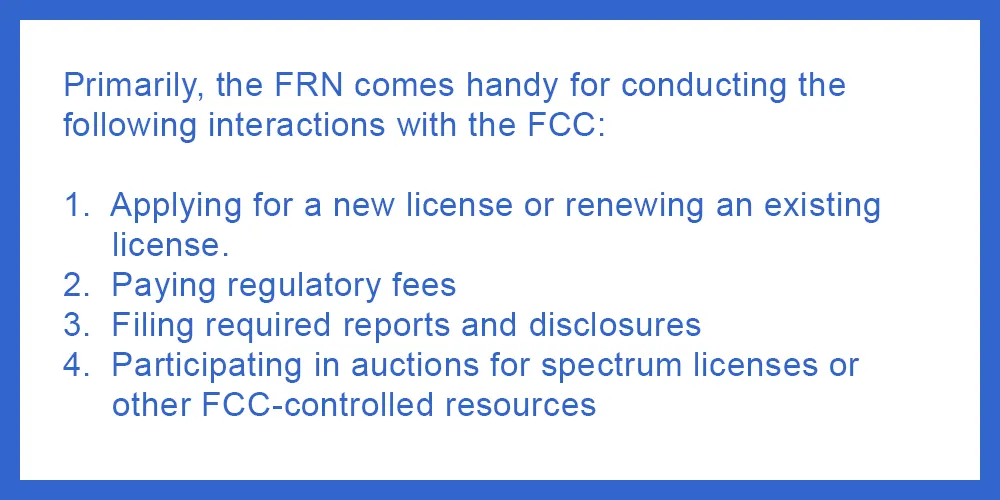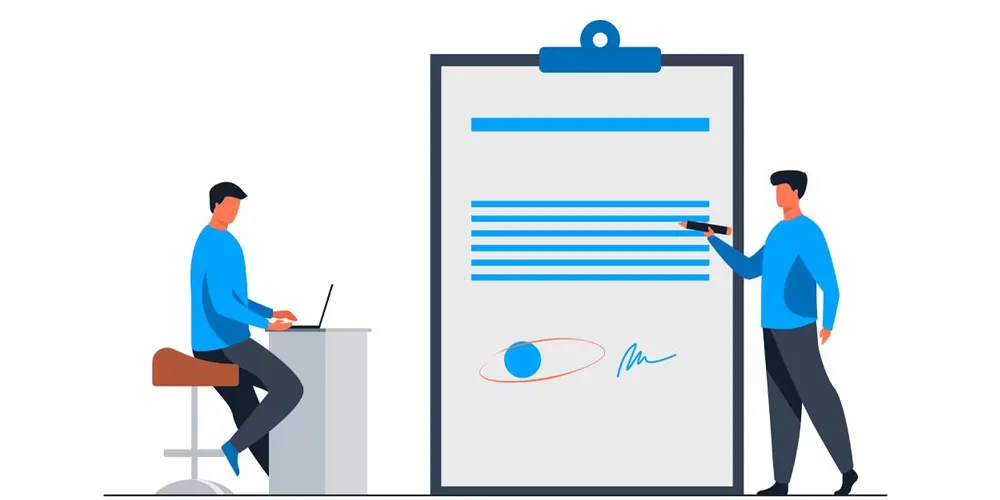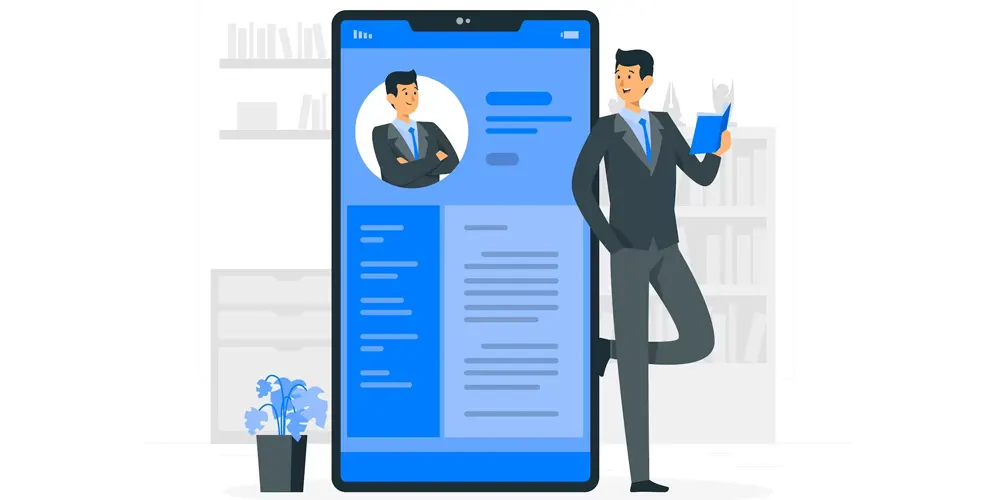Get Your FCC Registration Number in 5 Easy Steps!
Any existing VoIP operator or Carrier operating within the US market is aware of how important it is to have the FCC Registration Number. Simply put, the FRN is similar to carriers and VoIP providers as Social Security Number is for Americans.
It opens a lot of doors with the FCC for a carrier or VoIP operator along with the door to the US communications market. For any carrier or VoIP operator aiming to expand into the US market, obtaining an FRN is where everyone needs to start.
This article will be a thorough guide for you and educate you about everything you need to know about the FRN. You may then proceed and follow the step-by-step process presented herein to obtain an FRN for yourself.
But before we get there, let’s clear some basics, shall we?
An FCC Registration Number (FRN) is a unique 10-digit number assigned by the Federal Communications Commission (FCC) to different types of businesses and individuals that are regulated by the agency.
The FRN is used as a universal identifier for all transactions a regulated entity has with the FCC. It helps to streamline the process of applying for licenses, paying fees, and accessing other FCC services and participating in FCC undertakings.
The FRN is used by a wide range of entities that are regulated by the FCC, including broadcasters, cable operators, wireless carriers, telecom operators and carriers and manufacturers of telecommunications equipment.

To obtain an FRN, an individual or business must register with the FCC's Commission Registration System (CORES) and provide requested information.
The FRN simplifies the interaction process with the FCC. Instead of providing information such as the name of the business, type of operations, business address, etc., you only have to provide the FRN to the FCC.
The FRN is associated with a particular individual or business, and it can be used to access a variety of FCC services and resources.
This makes it an important tool for anyone who is involved in the telecommunications industry or who is subject to FCC regulations.
Before we get to the point where we discuss the FRN registration process, we need to take a look at all the prerequisites for obtaining an FRN.
What are the Prerequisites for Obtaining an FCC Registration Number (FRN)?
Several prerequisites must be met before one can apply to obtain an FRN. The prerequisites are as below:
1. Determine Eligibility

Before applying for an FCC Registration Number, you must determine if you are eligible. Individuals and entities that are eligible include citizens of the United States, permanent residents, and foreign entities that have been authorized by the FCC.
We shall check all the eligibility criterias in detail further below in this article.
2. Choose the Correct Application Form

The FCC offers various application forms, and it is important to choose the correct one. There are different forms for different types of entities or services that are provided.
Telecom operators, carriers and VoIP operators wanting to obtain the FRN, need to fill the FCC Form 605. Other important Fcc forms for the same group are the Form 499, Form 499-A, Form 499-Q, Form 477, Form 159 and Form 323.
3. Obtain a Taxpayer Identification Number (TIN)

Before applying for an FCC Registration Number, you must have a valid TIN. As the said entity will be operating commercially inside the United States, having a TIN is necessary. This helps the FCC keep a track of all the taxes and transactions.
For amateur radio and other non-commercial purposes, a Social Security Number (SSN) or an Employer Identification Number (EIN) are also used.
4. Pay the Required Fees

Like everything that involves government, a regulatory authority and registration, even this process requires you to pay a certain amount of fees.
The FCC charges fees for applications, such as applying for a new FCC Registration Number. These fees must be paid before the application can be processed.
5. Provide Accurate Information
The FCC requires that all information provided in the application is accurate and truthful. Any false or misleading information may result in the application being denied or the FCC revoking the FCC Registration Number.
Now that you know the prerequisites, we can check what are the Eligibility Criteria!
What is the Eligibility Criteria for Obtaining an FRN?
To apply for an FCC (Federal Communications Commission) Registration Number, you must meet certain eligibility criteria. These criteria are outlined below:
1. US Citizenship
To be eligible for an FCC Registration Number, you must be a citizen of the United States. If you are not a citizen, you may still be eligible if you meet certain conditions, such as being a permanent resident.
2. Authorization to Conduct Business in the United States
If you are a foreign entity, you must be authorized to conduct business in the United States. This may involve registering with the appropriate state or federal agency.
3. Compliance with FCC Rules
You must comply with all FCC rules and regulations related to the operation of radio transmitting equipment. This includes obtaining any necessary licenses or permits, using approved equipment, and following established operating procedures.
4. Technical and Operational Competence
You must have the technical and operational competence necessary to operate radio transmitting equipment safely and effectively. This may involve completing certain training or education programs and passing exams or tests.
5. Financial Responsibility
You must demonstrate financial responsibility and be able to pay any required fees or fines associated with the operation of radio transmitting equipment. This may involve providing proof of insurance or other financial guarantees.
6. No Criminal Background
You must have a good character and not have been convicted of any felonies or other crimes related to dishonesty or fraud. The FCC may also consider other factors, such as your reputation and business practices.
With every basic covered, we shall now proceed to understand the process to getting an FRN!
How to Obtain an FCC Registration Number (FRN)?
The FRN is one of the primary prerequisites for participating in any of FCC’s initiatives and for compliance. You may follow the steps below to obtain an FRN for your firm.
1. Visit the FCC's Commission Registration System (CORES) website

The first step in obtaining an FRN is to visit the CORES website. Here, you will be able to create an account and apply for your FRN. Create a CORES account and navigate to the CORES home page.
Select the “Register New FRN” option and follow the instructions given therein.
2. Provide Your Company's Information

You will be required to provide information about your company in the various stages of the FRN registration process. So keep all required pieces of information handy.
Information such as the legal name, address, and phone number will be needed to be submitted. You will also need to identify and verify the individual who will be the company's point of contact with the FCC.
3. Provide Your Personal Information

As the company's point of contact, you will need to provide your personal information, such as your name, email address, and phone number.
You will also need to furnish a valid government-issued ID, such as a driver's license or passport, to authenticate your identity. The identity verification process may take time.
4. Review and Submit Your Application
Once you have provided all of the necessary information, you will need to review your application and submit it to the FCC for processing.
It is important to ensure that all of the information is accurate and up-to-date before submitting your application.
5. Receive Your FRN
The FCC takes 24 hours to process a complete and error free FRN application. Delays are possible in case the application submitted is incomplete, the information is incorrect or missing.
After your application has been processed and approved, you will receive your FRN. This number should be kept confidential and used only for authorized transactions with the FCC.
If you want an even more detailed step-by-step process of obtaining an FRN, please refer to this guide.
Let’s say you obtained your FRN with the help of this guide, now what? For what purposes is the FRN useful for? Let's find out!
What Purposes is the FRN Useful For?
Introduced to simplify registration process and regular interactions with the FCC, the FRN is an important identifier for carriers and VoIP operators.
The FRN is a crucial tool for accessing a variety of FCC services and resources, including:
1. Applying for Licenses

An FRN is required for anyone who wants to apply for a license from the FCC, such as a radio or TV station license, or a license to operate a wireless network.
An FRN simplifies the licensing process, as it eliminates the need to provide basic information each time a license application is submitted.
2. Paying Regulatory Fees
The FCC charges regulatory fees for many of its services and activities. An FRN is required to pay these fees, and it helps to streamline the payment process by providing a universal identifier that can be used for all FCC-related financial transactions.
3. Filing Reports and Disclosures

Many types of entities regulated by the FCC are required to file regular reports and disclosures. This may include compliance reports, enquiry requests, investigation reports, complaints, etc.
An FRN is used to identify the filer and helps to ensure that the information provided is accurate and up-to-date.
4. Participating in Auctions

The FCC often auctions off licenses for use of the electromagnetic spectrum. Telecom operators and carriers can only operate in spectrums they are licensed to operate in.
An FRN is required for anyone who wants to participate in these auctions. This helps to ensure that only qualified bidders are allowed to bid on these valuable resources.
5. Accessing Other FCC Services
An FRN is also used to access a variety of other FCC services and resources, such as the Universal Licensing System (ULS), which is used to manage licenses for a wide range of telecommunications services.
The Robocall Mitigation Database is another example which requires one to have an FRN and register for the initiative to access it.
6. Participating in various FCC Initiatives
FCC has undertaken various initiatives such as Robocall Mitigation Database or STIR/SHAKEN to safeguard the citizens of America. All carriers who want to operate within the USA are required to actively participate in such initiatives.
Thus, having an FRN is the primary requirement for participating in any of FCC’s initiatives and thereby complying to rules and regulations.
Wrapping Up
Having an FRN is a preliminary requirement for any carrier or VoIP business who wishes to operate in the US market. It is required for everything from licensing, payments, participation in initiatives to actions and other things.
Before you apply for an FRN, ensure you satisfy the prerequisites of it and ensure you fit in the eligibility criteria for it. Once you’ve ensured all of this, you can proceed and follow the steps in this guide to obtain an FRN.
We hope this guide serves you well!
























































































































